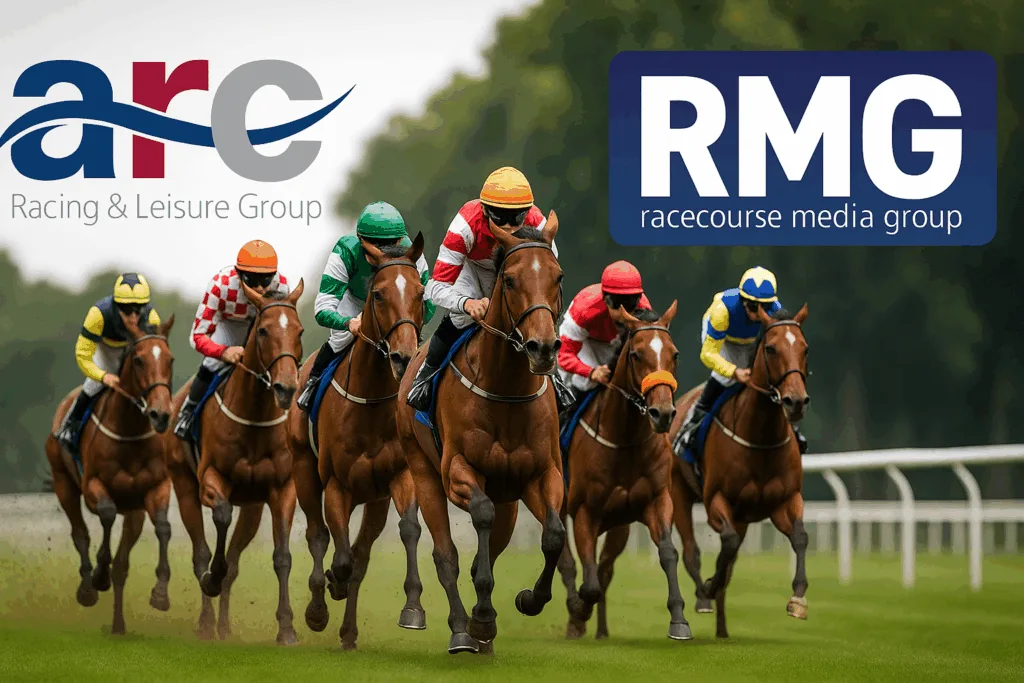
Horse Racing’s Split Between Courses
What are RMG and ARC?
Racecourse Media Group (RMG) and Arena Racing Company (ARC) are the two power-houses that package, sell and distribute the pictures, data and betting streams from Britain’s racecourses.
- RMG is a rights-holding co-operative: 34 shareholder courses – headed by the Jockey Club’s 15 tracks – pool their audio-visual and data rights. RMG in turn runs Racing TV for domestic subscription viewers, sells live pictures to bookmakers and streams racing to international partners. (Racecourse Media Group)
- ARC is an owner-operator: it owns 16 racecourses outright, controls five greyhound stadia and markets all of those rights (plus several partner tracks) mainly through Sky Sports Racing and its off-course arm The Racing Partnership (TRP). (Arena Racing Company)
Both groups sign multi-year contracts (the current cycle runs to 2029 for most courses) and negotiate separately with bookmakers, streaming services and broadcasters, which is why punters need more than one subscription to see every UK meeting.
Who’s in the RMG camp?
As of July 2025, the following 34 courses are RMG shareholders and appear on Racing TV:
Jockey Club – Aintree, Cheltenham, Epsom Downs, Haydock Park, Kempton Park, Market Rasen, Newmarket, Sandown Park, Warwick, Wincanton;
Major independents – Goodwood, York, Ayr, Hamilton Park, Musselburgh, Perth;
Flat specialists & regionals – Beverley, Carlisle, Catterick Bridge, Chelmsford City, Exeter, Fakenham, Leicester, Ludlow, Nottingham, Pontefract, Redcar, Salisbury, Stratford-on-Avon, Taunton, Thirsk, Wetherby, Cartmel.
RMG coverage accounts for roughly 70 % of Britain’s Pattern (Group and Graded) races.
Who’s on the ARC team?
ARC’s 16 owned courses – all shown live on Sky Sports Racing – stretch from Newcastle to Brighton and Bath:
Doncaster, Newcastle, Southwell, Lingfield Park, Wolverhampton, Royal Windsor, Bath, Brighton, Chepstow, Ffos Las, Fontwell Park, Hereford, Sedgefield, Uttoxeter, Worcester, Great Yarmouth.
ARC meetings make up around 39 % of all British fixtures and include the All-Weather Championships and the St Leger at Doncaster.
The independent racecourses
A small but influential cluster choose not to join either group’s shareholdings:
| Independent track | Current media home | Notable move |
|---|---|---|
| Ascot | Sky Sports Racing (domestic pictures) & ITV (terrestrial) | Stayed outside both pools to retain control of Royal Ascot rights. |
| Chester (plus Bangor-on-Dee) | Sky Sports Racing / TRP | Chester leads the Large Independent Racecourse Group. (LIR Group) |
| Newbury | Switched from RMG to TRP in Jan 2024 to boost media-rights income. | |
| Hexham, Newton Abbot, Plumpton, Ripon, Fakenham | TRP | Part of the seven-course independent set aligned with ARC’s TRP. |
These courses negotiate their own deals – usually with TRP for shop and streaming pictures – but retain full board-room control.
Why is the coverage split?
- Historic ownership – ARC was formed by merging Arena Leisure and Northern Racing, so its portfolio is owned outright. Most other courses preferred to keep local control yet collaborate on rights – hence the RMG co-op model.
- Commercial competition – Separate rights packages let tracks play broadcasters and bookmakers off against one another to maximise fees. Newbury’s 2024 jump to TRP (and the promised 13 % prize-money rise) is a textbook example.
- Different product strategies – Racing TV sells a pure racing subscription; Sky Sports Racing bundles racing inside the wider Sky ecosystem, expanding reach for smaller fixtures.
- Regulatory freedom – UK racecourses individually own their media and betting-data IP, so there is no central league-style rights sale as you’d find in football.
- Betting-shop pictures vs home viewing – Off-course betting streams generate a separate, highly lucrative revenue line; ARC’s TRP and RMG strike different turnover-based deals with bookmakers, leading to varied payouts and, occasionally, public spats about “who gets the bigger slice”.
Tracking technology: TPD, Coursetrack & RaceiQ
Total Performance Data (TPD) and Coursetrack sit at the heart of Britain’s live tracking revolution, but each media group has taken a different route.
- TPD in the ARC sphere – Every ARC-owned course (and most of the aligned independents) carries TPD’s GNSS/GPS saddle-cloth sensors. The data powers the on-screen Race Pace graphic on Sky Sports Racing and feeds in-play odds and Bet Angel.
- Coursetrack in the RMG world – RMG invested in Coursetrack’s second-generation lightweight trackers, which transmit position data to Racing TV’s London hub. The raw feed is then modelled by RaceiQ, RMG’s in-house analytics layer that generates finishing-speed percentages, par sectionals and stride metrics now shown free on Racing TV apps.
- 2025 update – TPD secured the right to distribute live GPS data from all RMG courses to its subscribers, which means professional punters are able to work from one technology stack regardless of fixture.
Key takeaways
- RMG = co-operative rights holder (34 tracks) → Racing TV
- ARC = owner-operator (16 tracks) → Sky Sports Racing + TRP
- Independents such as Ascot, Chester and Newbury keep their own counsel but typically sell shop streams via TRP.
- The split is driven by ownership structures, commercial negotiation and the value of betting-shop pictures.
- For full UK coverage, racing fans still need both subscriptions – a quirk unlikely to change before the next rights cycle begins in 2030.
